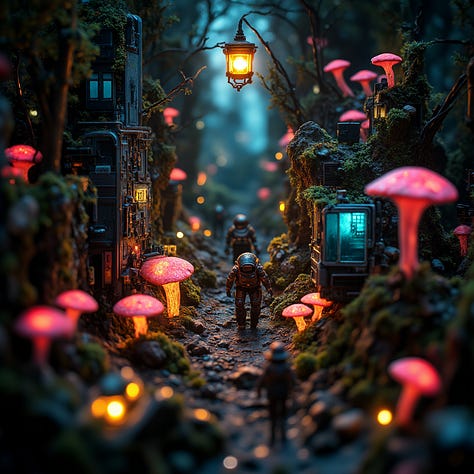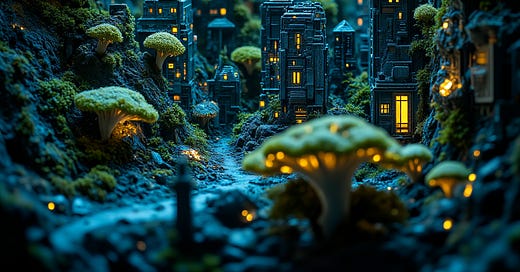Welcome and thanks for joining me for the inaugural edition of The High-Tech Creative’s Prompt of the week! Each week i’m going to break down one of my favourite prompts and show you how to experiment using it as a base to start from.
If you’ve not yet seen it, please feel free to read our short guide to AI image model prompting below. It’s not necessary to have read this to follow along, i’ll go over the basics again, but if you enjoy AI Art it’s worth a read.
Prompting Like a Pro
The High-Tech Creative is an independent arts and technology journalism and research venture entirely supported by readers like you. The most important assistance you can provide is to recommend us to your friends and help spread the word. If you enjoy our work however and wish to support it continuing (and expanding) more directly, please click through…
A brief reminder that The High-Tech Creative is an independent arts and technology journalism and research venture entirely supported by readers like you. The most important assistance you can provide is to recommend us to your friends and help spread the word. If you enjoy our work however and wish to support it continuing (and expanding) more directly, please click through below. For the price of a cup of coffee, you can help a great deal.
A Virtual World in Miniature
Today we’re looking at virtual dioramas, generating images with the look and style of a handmade diorama photographed.
For those not familiar, a diorama is a small model, a physical landscape in miniature. They can be made for many reasons by many different types of hobbyists: wargamers, miniature train enthusiasts, visual effects artists; before the advent of CGI, dioramas and models were the state of the art of visual effects thanks to Lucas and his team.
It may seem counter intuitive, but for as long as people have been making digital imagery, they’ve also been making virtual dioramas. Whether it was 3d scenes carefully rendered to give the look of plastic and foam, or virtual Lego scenes rendered in detail along with working instructions, the style has been with us for quite some time.
Lets break down the prompt!
Key Elements
As discussed in Prompting like a Pro, the core elements of a prompt can be broken down into the Style, the Subject and the Composition, with the use of moods and emotives to help shade the image. This is what we’ve done here.
Style
A miniature diorama crafter from reclaimed electronic waste.
Here we determine the overall type of art we want to create, the answer to “what kind”. Whilst all models behave differently, it’s not uncommon for models to give more weight to elements that appear earlier in the prompt - as this is the element that will most influence all others, it’s best added up front.
It’s also worth noting elements of your prompt that may be more unusual than others - in this case the electronic waste. It’s a good match for the subject we’ve chosen and is responsible for the textured look of the buildings in the image above, however it is a less usual request and likely to get lost in some renderings of the prompt. If this element is particularly important to the composition, it’s the one most likely to require reinforcement later in the prompt to ensure it appears.
There’s no need to be overly wordy with this, we can keep it succinct and to the point.
Subject
An overgrown futuristic cityscape
When choosing a subject it’s important to consider the style, the medium, and make a conscious decision about what you are creating. Here, we choose a complementary subject: A diorama of reclaimed electronics is an excellent choice for depicting a ruined cityscape. More difficult, but often incredibly powerful, is deliberately mismatching the subject and style for added effect.
Composition & Framing
A macro, eye-level perspective.
For this image we want to be down almost inside the diorama itself, a model’s eye view. Specifying the use of macro photography amplifies this effect with a shallow depth of field, making the entire composition more expansive and three dimensional.
Emotive modifiers
Evoking a sense of eerie beauty and decay.
A powerful and subtle technique to use with modern image models is to feed in the aesthetic mood you want to evoke with the image. This will have a small effect on the overall image, but it can shift colours, lighting and even composition towards a better representation of the effect you’re trying to create.
Great, lets bring it all together:
A miniature diorama crafted from reclaimed electronic waste, illuminated by the flickering light of a single repurposed LED, depicting a futuristic cityscape overgrown with bioluminescent fungi, evoking a sense of eerie beauty and decay with a macro, eye-level perspective.



This is the initial prompt used for our first image above as well, as you can see we get some significant variety but its capturing the requests we made.
Changing it up
Lets experiment and see how small changes using this prompt as a base can allow us to explore a world in miniature.
Modified Subject
Firstly, lets reconsider the fungi. I’m not a big fan of them aesthetically, and the bioluminescent effect, though pretty, does wash out the “single repurposed LED” we requested in the prompt.
A miniature diorama crafted from reclaimed electronic waste, illuminated by the flickering light of a single repurposed LED, depicting a futuristic cityscape overgrown with
bioluminescent fungicreepers and small trees, evoking a sense of eerie beauty and decay with a macro, eye-level perspective.
The whole tone of the image shifts with this request, leaning much harder on the decay now that we’ve lost the bioluminescence.
Shift the lighting
Losing the mushrooms takes away a lot of colour from our image too however, lets see if we can bring back a little by modifying how we want the lighting rendered.
A miniature diorama crafted from reclaimed electronic waste, illuminated by the flickering light of
a single repurposed LEDrepurposed neon LEDs, depicting a futuristic cityscape overgrown with creepers and small trees, evoking a sense of eerie beauty and decay with a macro, eye-level perspective.
Now we’re cooking with gas. The change in lighting has dimmed the entire scene but also added much more of a sense of life. We’re seeing decay, but also life and beauty amongst it.
Pushing the Subject
It would be interesting to see how this prompt will react with a different subject, something less structured than a city and more chaotic, but in keeping with our themes.


A miniature diorama crafted from reclaimed electronic waste, illuminated dimly by the flickering light of repurposed LEDs, depicting
a futuristic cityscape overgrown with creepers and small treesrobed figures conducting a religious service for a motley group of apocalypse survivors in a makeshift camp, evoking a sense of eerie beauty and decay with a macro, eye-level perspective.
The prompt makes for an excellent, eerie post-apocalyptic cult diorama. This is an example of where some elements can get lost however, the reclaimed electronics take more of a backseat in these images, though their influence still shows through primarily in the lighting: the led-powered campfire in the first, the small hanging light in the second.
If this was an important part of the composition, this is a time where we could reinforce that element to try and get it more prioritised by the model.
A miniature diorama crafted from reclaimed electronic waste, illuminated dimly by the flickering light of repurposed LEDs, depicting robed figures conducting a religious service for a motley group of apocalypse survivors in a makeshift camp made of the reclaimed electronics, evoking a sense of eerie beauty and decay with a macro, eye-level perspective.
The additional mention there reinforced our desire for that element, and now it appears we have created out camp out of old circuit boards and the ground and foreground is scattered with pieces that look torn from old circuits.
Tonal Shift
For a final experiment, lets shrug off the grim eeriness and go for something brighter, more cheerful, using the general structure of the prompt to provide us with something wildly different.
A miniature diorama crafted from reclaimed electronic waste,
illuminated dimly by the flickering light of repurposed LEDs, depicting robed figures conducting a religious service for a motley group of apocalypse survivors in a makeshift camp made of the reclaimed electronicsbrightly lit by sunlight, depicting a busy beach full of revellers at a tropical resort, evoking a sense ofeerie beauty and decaycheer and relaxation with a macro, eye-level perspective.
A very different result. We’ve lost the electronics components again as we reverted the reinforcement, but we definitely got a large scoop of cheer and relaxation in this image.
What next?
Now it’s your turn! Take this prompt, tinker with it, experiment, and see what you can create on your own.
If you enjoy the prompt, hit me up on social media with a picture of what you’ve created, I’d love to see it. Post to instagram or bluesky with #HTCWeeklyPrompt and tag me directly, @hightechcreative on instagram or @hightechcreative.bsky.social on bluesky.
See you next time!
About Us
The High-Tech Creative
Your guide to AI's creative revolution and enduring artistic traditions
Publisher & Editor-in-chief: Nick Bronson
Fashion Correspondent: Trixie Bronson
AI Contributing Editor and Poetess-in-residence: Amy
If you have enjoyed our work here at The High-Tech Creative and have found it useful, please consider supporting us by sharing our publication with your friends, or click below to donate and become one of the patrons keeping us going.










